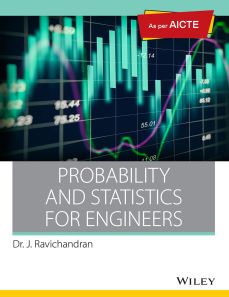Probability and Statistics for Engineers, As per AICTE
ISBN: 9788126512348
612 pages
For more information write to us at: acadmktg@wiley.com

Description
Probability and Statistics for Engineers is written for undergraduate students of engineering and physical sciences. Besides the students of B.E. and B.Tech., those pursuing MCA and MCS can also find the book useful. The book would be equally helpful for six sigma practitioners in industries. Comprehensive yet concise, the text is well-organized in 15 chapters that can be covered in a one-semester course in probability and statistics. Designed to meet the requirements of engineering students, the text covers all important topics, emphasizing basic engineering and science applications.
1. Probability Concepts
1.1 Introduction
1.2 Important Definitions
1.3 Approaches of Measuring Probability
1.4 Bayes’ Theorem
2. Random Variables and Distribution Functions
2.1 Introduction
2.2 Random Variable
2.3 Discrete Random Variable
2.4 Continuous Random Variable
2.5 Cumulative Distribution Function
3. Expectation and Moment-Generating Function
3.1 Introduction
3.2 Definition and Properties of Expectation
3.3 Moments and Moment-Generating Function
4. Standard Discrete Distribution Functions
4.1 Introduction
4.2 Discrete Distributions
5. Some Standard Continuous Distribution Functions
5.1 Introduction
5.2 Uniform Random Variable and Its Distribution
5.3 Exponential Random Variable and Its Distribution
5.4 Gamma Random Variable and Its Distribution
5.5 Normal Random Variable and Its Distribution
6. Chebyshev’s Inequality and Central Limit Theorem
6.1 Introduction
6.2 Chebyshev’s Theorem (or Inequality)
6.3 Asymptotic Properties of Random Sequences
6.4 Central Limit Theorem
7. Two-Dimensional Random Variables
7.1 Introduction
7.2 Discrete Case: Joint Probability Mass Function
7.3 Continuous Case: Joint Probability Density Function
7.4 Stochastic Independence of Random Variables
7.5 Expectation of Two-Dimensional Random Variables
7.6 Conditional Mean and Conditional Variance
8. Transformation of Random Variables
8.1 Introduction
8.2 One-Dimensional Random Variable
8.3 Two-Dimensional Random Variables
9. Point Estimation and Minimum Risk Estimator
9.1 Introduction
9.2 Types of Estimation
10. Sampling Distributions and Interval Estimation
10.1 Introduction
10.2 Sampling Distributions
10.3 Interval Estimation
11. Testing of Hypotheses
11.1 Introduction
11.2 Testing of Hypothesis
11.3 Classification of Hypothesis Tests
11.4 Large Sample Tests
11.5 Small Sample Tests
12. Simple Correlation and Regression
12.1 Introduction to Simple Correlation
12.2 Properties of Correlation Coefficient
12.3 Rank Correlation Coefficient
12.4 Introduction to Simple Regression
13. Analysis of Variance: One-Way and Two-Way Analyses
13.1 Introduction
13.2 Single-Factor (One-Way ANOVA) Experiment and Linear Statistical Model
13.3 Fixed Effects Model and ANOVA
13.4 Random Effects Model and ANOVA
13.5 Computations for Sum of Squares
13.6 Multiple Comparison Test: Grouping of Means
13.7 Single-Factor (Two-Way ANOVA) Experiment and Linear Statistical Model (Completely Randomized Block Design)
13.8 Fixed Effects Model for Two-Way ANOVA
13.9 Random Effects Model for Two-Way ANOVA
13.10 Computations for Sum of Squares
14. Latin Square Design and Two-Factor Factorial Design
14.1 Introduction
14.2 Latin Square Design
14.3 Two-Factor Factorial Experiment
15. Statistical Quality Control and Six Sigma Metrics
15.1 Introduction
15.2 Statistical Quality Control
15.3 Control Charts for Variables
15.4 Control Charts for Attributes
15.5 Out-of-Control Situations in Control Charts and Process Monitoring
15.6 Process Capability and Process Capability Index
15.7 Six Sigma
Appendix A Other Standard Distributions
Appendix B Standard Normal Table
Appendix C t-Table
Appendix D Chi-Square Table
Appendix E F-Table
Appendix F Construction of Various Control Charts
Appendix G Least Significant Studentized Ranges
Answers
Index

